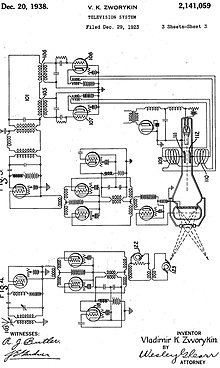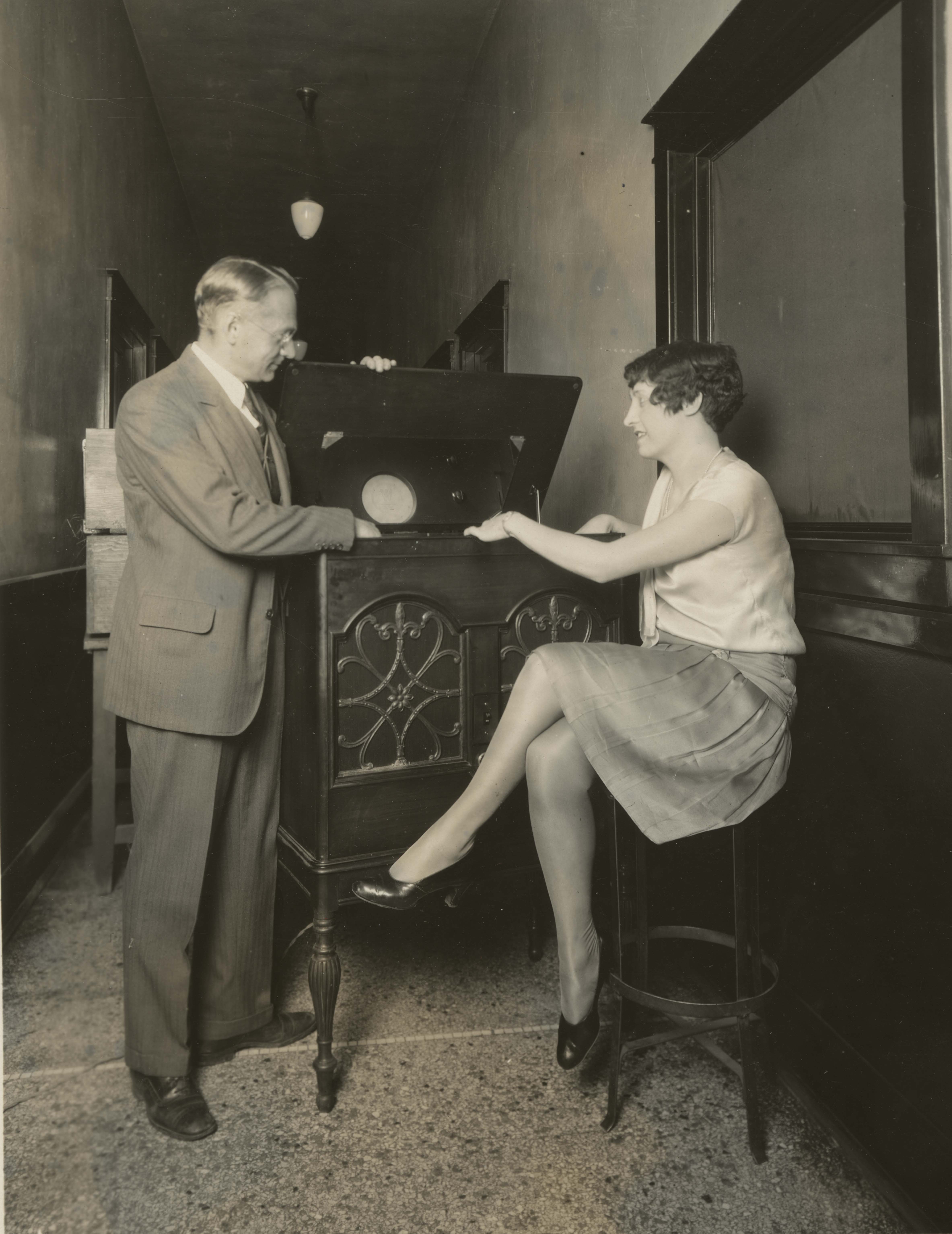Vladimir K. Zworykin
Vladimir Kozmich Zworykin | |
|---|---|
| File:Zworykinkinescope.jpg Vladimir Zworykin, 1929, holding his kinescope | |
| Born | July 30, 1889 |
| Died | July 29, 1982 (aged 92) |
| Citizenship | American |
| Education | Saint Petersburg State Institute of Technology |
| Occupation | Engineer |
| Known for | Inventor of the kinescope and other components of early television technology |
| Spouse | Katherine Polevitzky (m. 1951) 2nd wife |
| Awards | IRE Medal of Honor, 1951, IEEE Edison Medal, 1952 |
| Engineering career | |
| Projects | Television, Electron Microscope |
| Significant design | Iconoscope, Photomultiplier |
Vladimir Kozmich Zworykin (Russian: Владимир Козьмич Зворыкин) (July 30, 1889 - July 29, 1982) was a Russian-American inventor, engineer, and pioneer of television technology. Zworykin invented a television transmitting and receiving system employing cathode ray tubes. He played a role in the practical development of television from the early thirties, including charge storage-type tubes, infrared image tubes and the electron microscope. Several biographers have called him the "true" inventor of television, although there remains healthy dispute about this designation.
Biography
Zworykin was born in Murom, Russia, in 1889, perhaps on July 30, to the family of a prosperous merchant. He had a relatively calm upbringing, rarely seeing his father except on religious holidays. He studied at the St. Petersburg Institute of Technology, under Boris Rosing. According to recently discovered accumulated personal correspondence of Zworykin, he helped Boris Rosing with experimental work on television in the basement of Rosing's private lab at the School of Artillery of Saint Petersburg, Russia. Rosing had filed his first patent on a television system in 1907, featuring a very early cathode ray tube as a receiver, and a mechanical device as a transmitter. Its demonstration in 1911, based on an improved design, was among the first demonstrations of TV of any kind.


Although most biographies maintain that Zworykin graduated in 1912 and, thereafter, studied X-rays under Professor Paul Langevin in Paris, in the above referenced correspondence Zworykin gives the dates of having studied with Rosing as between 1910 and 1914. In any case, during World War I, Zworykin was enlisted and served in the Russian Signal Corps, then succeeded in getting a job working for Russian Marconi, testing radio equipment that was being produced for the Russian Army. Zworykin decided to leave Russia for the United States in 1918, during the Russian Civil War. He left through Siberia, travelling north on the River Ob to the Arctic Ocean as part of an expedition led by Russian scientist Innokenty P. Tolmachev, eventually arriving in the US at the end of 1918. He returned to Omsk , then capital of Admiral Kolchak's government in 1919, via Vladivostok, then to the United States again on official duties from the Omsk government. These duties ended with the collapse of the White movement in Siberia at the death of Aleksandr Kolchak. Zworykin decided, this time, to remain permanently in the US.
Once in the U.S., Zworykin found work at the Westinghouse laboratories in Pittsburgh, where he eventually had an opportunity to engage in television experiments. He summarized the resulting invention in two patent applications. The first, entitled "Television Systems", was filed on December 29, 1923, and was followed by a second application of essentially the same content, but with minor changes and the addition of a Paget-type screen for color transmission and reception.[citation needed] He was awarded a patent for the 1923 application in 1938[1], although the equipment described was never successfully demonstrated.[citation needed]

Zworykin described cathode ray tubes as both transmitter and receiver. The operation, whose basic thrust was to prevent the emission of electrons between scansion cycles, was reminiscent of A. A. Campbell Swinton's proposal published in Nature in December 1911. This would result in the television signal being derived from the modest number of electrons released at the instant the cathode ray swept over an image point.[citation needed]
The demonstration given by Zworykin sometime in late 1925 or early 1926 — not in 1923, as popular accounts would have it — was far from a success with the Westinghouse management, even though it showed the possibilities inherent in a system based on the Braun tube. Although he was told by management to "devote his time to more practical endeavours", Zworykin continued his efforts to perfect his system. As attested to by his own writing, including his doctoral dissertation of 1926, earning him a PhD from the University of Pittsburgh, his experiments were directed at improving the output of photoelectric cells.
There were, however, limits to how far one could go along these lines, and so, in 1929, Zworykin returned to vibrating mirrors and facsimile transmission, filing patents describing these. At this time, however, he was also experimenting with an improved cathode ray receiving tube, filing a patent application for this in November 1929, and introducing the new receiver that he named "Kinescope", reading a paper two days later at a convention of the Institute of Radio Engineers.
Having developed the prototype of the receiver by December, Zworykin met David Sarnoff, who eventually hired him and put him in charge of television development for RCA at their newly established laboratories in Camden, New Jersey.
The move to the laboratories occurred in the spring of 1930 and the difficult task of developing a transmitter could begin. There was an in-house evaluation in mid-1930, where the kinescope performed well (but with only 80 lines definition), and the transmitter was still of a mechanical type. A "breakthrough" would come when the Zworykin team decided to develop a new type of cathode ray transmitter, one described in the French and British patents of 1928 priority by the Hungarian inventor Kalman Tihanyi whom the company had approached in July 1930, after the publication of his patents in England and France. This was a curious design, one where the scanning electron beam would strike the photoelectric cell from the same side where the optical image was cast. Even more importantly, it was a system characterized by an operation based on an entirely new principle, the principle of the accumulation and storage of charges during the entire time between two scansions by the cathode-ray beam.
According to Albert Abramson, Zworykin's experiments started in April 1931, and after the achievement of the first promising experimental transmitters, on October 23, 1931, it was decided that the new camera tube would be named Iconoscope. The system was ready to be launched at the end of 1934, a contract had of course been signed with the Hungarian inventor for the purchase of his patents. In early 1935, the new tube was introduced in Germany. It was soon developed there, with some improvements, and was successfully used at the 1936 Berlin Olympic Games as one of several cameras, including Philo Farnsworth's Image Dissector for film transmission only, broadcasting the games to some two-hundred public theaters. Although the tube went through a number of adjustments and improvements, it continued to be called by the generic name of Iconoscope.
The developments in England, by the British firm Marconi/EMI, followed the original charge storage design under a patent exchange. This electronic system was officially adopted by the BBC whose experimental public broadcasts began in England in November 1936 and initially included the Baird-system. The British electronic system featured 405 scanning lines, while German television adopted 441 line scanning and so did RCA following the initial (1934) 375 line definition.
Second marriage and retirement
Zworykin married for a second time in 1951. His wife was Katherine Polevitzky, a Russian-born professor of bacteriology at the University of Pennsylvania. It was the second marriage for both. The ceremony was in Burlington, New Jersey. [3] He retired in 1954.
Death
He died on July 29, 1982 in Princeton, New Jersey. [4]
Honors
Throughout his steady rise in rank, he remained involved in the many important developments of the company and received several outstanding honours, including, in 1934, the AIEE Morris N. Liebmann Memorial Award.
Legacy
He was inducted into the New Jersey Inventor's Hall of Fame; and the National Inventors Hall of Fame Additionally, Tektronix in Beaverton, Oregon has named a street on their campus after Zworykin.
Quote
"I hate what they've done to my child...I would never let my own children watch it."
- Vladimir Zworykin on his feelings about watching television.
See also
- List of people known as "father" or "mother" of something
- Philo Farnsworth
- John Logie Baird
- Kalman Tihanyi
References
This article includes a list of references, related reading, or external links, but its sources remain unclear because it lacks inline citations. (April 2009) |
- ^ a b c Zworykin, V. K., Television System, United States Patent Office, Patent No. 2,141,059, 1938-12-20, retrieved 2009-06-03.
- ^ Method of and Apparatus for Producing Images of Objects, United States Patent Office, Patent No. 2,021,907, 1935.
- ^ "Married". Time (magazine). November 26, 1951. Retrieved 2008-04-27.
Vladimir Zworykin, 62, Russian-born, Russian-trained physicist, the "father of television," who developed the iconoscope (eye) of the TV camera in 1923, now laments: "We never dreamed of Howdy Doody on Television — we always thought television would find its highest value in science and industry"; and Katherine Polevitzky, 62, Russian-born professor of bacteriology at the University of Pennsylvania; both for the second time; in Burlington, New Jersey.
{{cite news}}: Check date values in:|date=(help); Cite has empty unknown parameter:|coauthors=(help) - ^ "Vladimir Zworykin, Television Pioneer, Dies at 92". New York Times. August 1, 1982. Retrieved 2008-04-27.
Dr. Vladimir Kosma Zworykin, a Russian-born scientist whose achievements were pivotal to the development of television, died Thursday at the Princeton (N.J.) Medical Center. He was 92 years old and lived in Princeton. Dr. Zworykin, a naturalized American citizen who was also credited with spearheading development of the electron ...
{{cite news}}: Check date values in:|date=(help); Cite has empty unknown parameter:|coauthors=(help)
Further reading
- Albert Abramson: "The History of Television 1880 to 1941", Jefferson: McFarland, 1987
- Albert Abramson: "Die Geschichte des Fernsehens 1880 bis 1941", München, Fink Verlag, 2003
- Albert Abramson: "Zworykin, Pioneer of Television", University of Illinois Press, Champaign, 1995
- Fritz Schröter: "Handbuch der Bildtelegraphie und des Fernsehens", Berlin: Julius Springer, 1932
- Fritz Schröter: "Fernsehen. Die neueste Entwicklung insbesondere der deutschen Fernsehtechnik", Berlin: Julius Springer, 1937
- Walter Bruch: "Kleine geschichte des deutschen Fernsehens", Berlin: Hande & Spender, 1967
- The Farnsworth Invention: Fact -v- Fiction
- Abramson, Vladimir Zworykin: Pioneer of Television
- A 1975 interview with Vladimir Zworykin
- Zworykin's biography at the IEEE History Center
- Compilation of biographies of Vladimir Zworykin- including photographs and bibliography, compiled by Prof. Eugenii Katz of The Hebrew University.
- Recipients of the IEEE Vladimir K. Zworykin Award
- 1889 births
- 1982 deaths
- Naturalized citizens of the United States
- People from Pittsburgh, Pennsylvania
- University of Pittsburgh alumni
- Russian inventors
- Russian engineers
- American inventors
- American engineers
- Russian-American inventors
- Television pioneers
- Russian Orthodox Christians
- National Medal of Science laureates
- IEEE Medal of Honor recipients
- IEEE Edison Medal recipients
- American Eastern Orthodox Christians
- Russian Eastern Orthodox Christians
